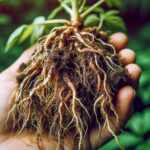Root rot caused by the pathogen Phytophthora sojae is a devastating disease that affects soybeans, one of the most important crop plants worldwide. This pathogen is an oomycete, a type of organism similar to fungi but differing in its biology and life cycle.
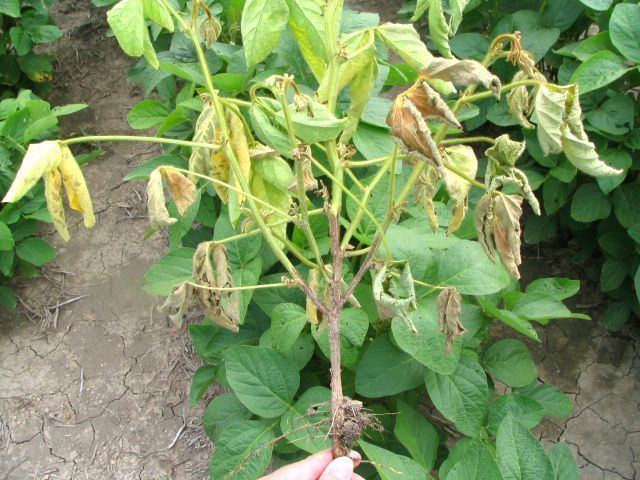
Phytophthora sojae is a pathogen that causes root rot in soybean plants, which can result in significant losses in the production of this important crop. Root nutrition in the presence of this pathogen is crucial to understanding how the plant responds to infection and how it can be effectively managed.
When soybean roots are infected by Phytophthora sojae, the pathogen invades the root cells, resulting in tissue decay. This negatively affects the plant’s ability to absorb water and nutrients from the soil, leading to poor growth and, in severe cases, plant death.

Root nutrition of soybeans infected with Phytophthora sojae can be affected in several ways:
- Decreased nutrient absorption: The presence of the pathogen can interfere with the plant’s ability to absorb nutrients from the soil, resulting in nutritional deficiencies.
- Blockage of water and nutrient flow: Infection by Phytophthora sojae can clog root conduits, making it difficult for water and nutrients to flow through the plant.
- Alteration of plant physiology: The presence of the pathogen can trigger physiological responses in the plant, such as the production of antioxidant compounds or the activation of specific metabolic pathways, which can affect nutrient absorption and utilization.
In this article, we will explore the life cycle of the pathogen and the symptoms it produces in soybean cultivation, which will help you identify if it is present in your crop.

Life Cycle
The life cycle of Phytophthora sojae, the causal agent of root rot in soybeans, is complex and comprises several stages.
Oospores: The life cycle of Phytophthora sojae begins with the presence of oospores in the soil.
Sporangia: Under favorable conditions, oospores germinate and produce primary sporangia through specialized structures called sporangiophores.
Production of zoospores: Primary sporangia release zoospores in response to environmental stimuli such as the presence of water.
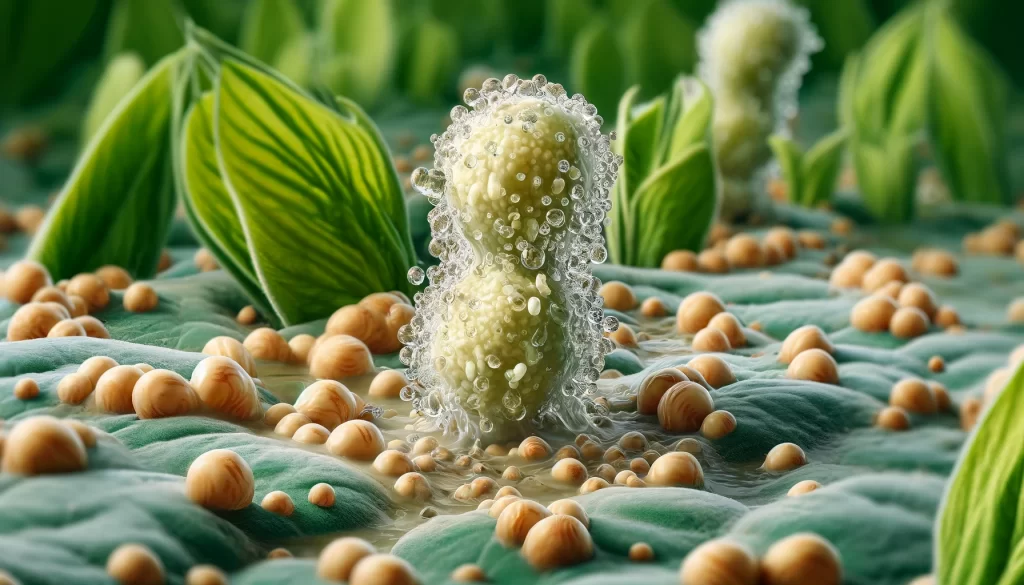
Infection: Once zoospores reach the roots of the soybean plant, they can infect root cells and penetrate plant tissue.
Formation of mycelium: Once inside the plant, Ph ytophthora sojae forms branched mycelium that extends and colonizes root tissue. This mycelium can grow along the roots and cause tissue decay, resulting in rot symptoms.
Asexual cycle: Under certain environmental conditions, such as the presence of water and moderate temperatures, Phytophthora sojae can produce secondary sporangia on infected plant tissue.
Sexual cycle (optional): Under some conditions, Phytophthora sojae may undergo a sexual life cycle involving the formation of oospores.
Infection Symptoms
Infection by Phytophthora sojae in soybean plants can manifest through a variety of symptoms, which may vary depending on the plant’s developmental stage and environmental conditions. Here’s a description of typical symptoms of Phytophthora sojae infection:
Wilting: One of the initial symptoms of Phytophthora sojae infection is wilting of the plant’s leaves and shoots. Leaves may show signs of dehydration and begin to wilt even when the soil is adequately moist.

Yellowing of leaves: As the infection progresses, plant leaves may begin to yellow, especially at the edges and tips. This yellowing may gradually spread throughout the leaf as the disease progresses.
Necrosis of roots: Phytophthora sojae primarily infects the roots of the soybean plant, which can lead to tissue death and root necrosis. This root damage can hinder the plant’s ability to absorb water and nutrients.
Root rot: Infection by Phytophthora sojae can cause rotting of the roots, manifested as darkening and decomposition of root tissue. Roots may become soft and brittle and may easily detach from the rest of the plant.
Premature leaf drop: As the infection progresses and the plant weakens, premature leaf drop may occur. Infected leaves may become necrotic and detach from the plant earlier than normal.
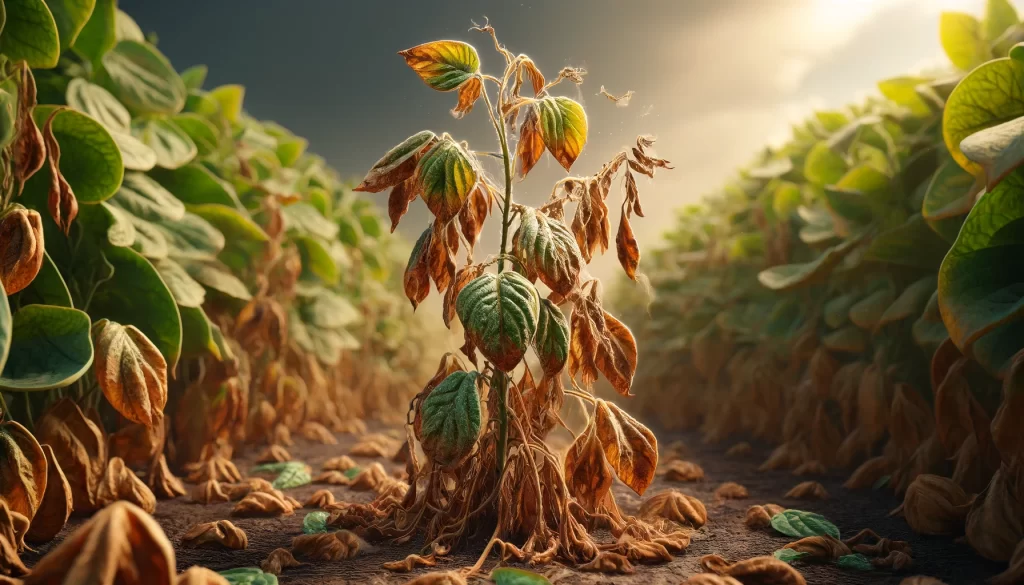
Decreased growth: Infection by Phytophthora sojae can reduce the growth and development of the soybean plant, resulting in smaller plant size and vigor, as well as decreased pod and grain production.
Use of Specific Fungicides and Biofungicides to Control Pathogen Spread.
The use of specific fungicides and biofungicides is an important strategy for controlling the spread of the pathogen Phytophthora sojae and reducing damage to soybean crops. Here are some considerations regarding their use:
- Conventional fungicides: Conventional fungicides are chemical products designed to kill or inhibit the growth of fungi and pathogens. In the case of Phytophthora sojae, specific fungicides effective against this pathogen can be applied. It is important to follow application recommendations and proper dosages to ensure optimal efficacy and minimize risks to the environment and human health.
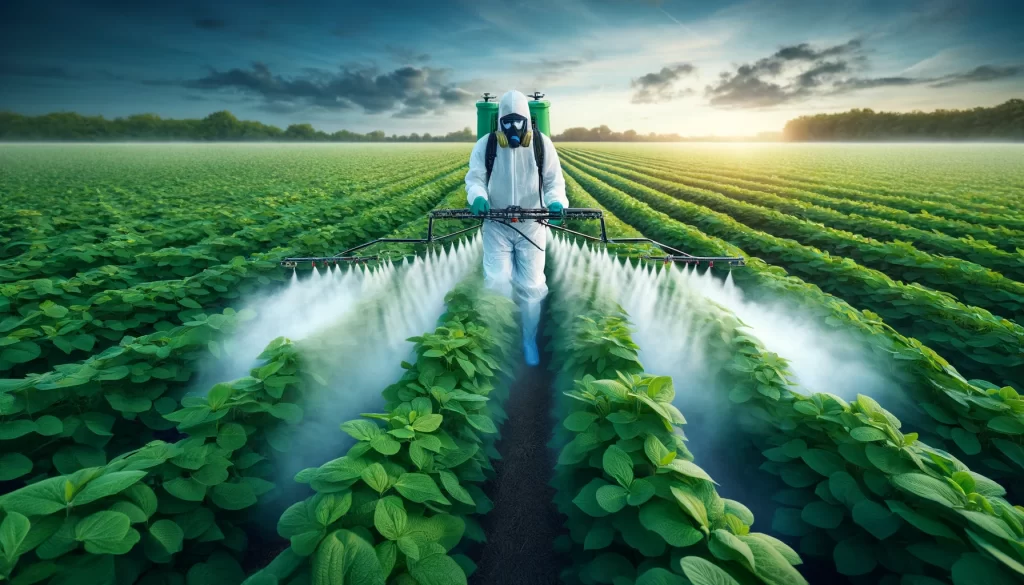
- Biofungicides: Biofungicides are products derived from living organisms, such as bacteria, fungi, or other microorganisms, that have the ability to suppress or control pathogen growth. In the case of Phytophthora sojae, several biofungicides have been researched and developed that show antifungal activity against this pathogen. These products can be a more sustainable and environmentally friendly alternative compared to chemical fungicides. Some examples of biofungicides include strains of Trichoderma spp., Bacillus spp., and Pseudomonas spp., among others.
- Application mode: Both conventional fungicides and biofungicides should be applied in a timely and proper manner to achieve the best results. This may include preventive treatments before disease symptoms appear, as well as curative applications once infection is detected. It is important to follow manufacturer recommendations regarding dosage, application frequency, and application technique to maximize efficacy and minimize risks.
- Integration with other management practices: The use of fungicides and biofungicides should be integrated with other integrated pest and disease management practices to achieve effective and sustainable control of Phytophthora sojae. This may include selection of resistant soybean varieties, crop rotation, proper irrigation and fertilization management, and promotion of soil health.
 AgronoBlog – Agriculture Blog
AgronoBlog – Agriculture Blog 
